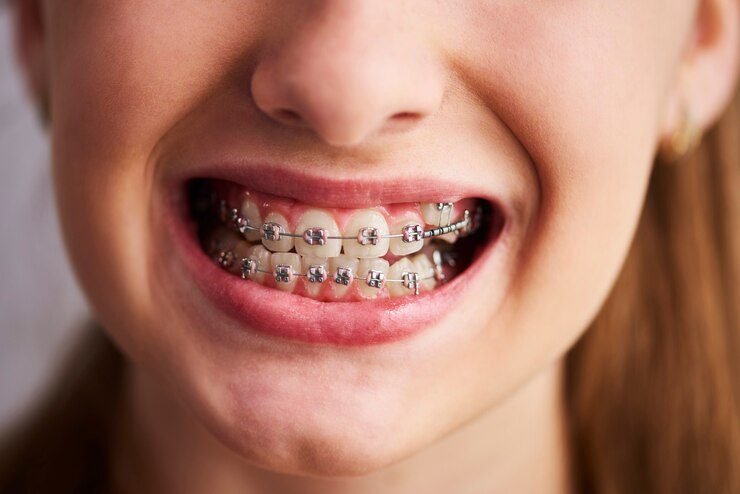Physical Address
304 North Cardinal St.
Dorchester Center, MA 02124
Physical Address
304 North Cardinal St.
Dorchester Center, MA 02124

Plan and budget for the cost of braces with these essential tips.
When considering the cost of braces, there are several factors that must be taken into account to ensure an accurate budget. Firstly, the type of braces chosen will greatly impact the overall cost. Traditional metal braces are often the most affordable option, while ceramic or clear braces may come with a higher price tag. Additionally, invisible aligners such as Invisalign might be a more expensive choice, but offer a more discreet and comfortable option.
Another factor to consider is the severity of the orthodontic issue. The complexity of the dental problem can influence the duration of the treatment, which in turn affects the cost. More extensive corrections may require longer treatment times and more frequent adjustments, leading to higher expenses. It’s important to consult with an orthodontist to assess the specific needs and determine the most appropriate treatment plan for both the desired outcome and budget.
| Factor | Description |
|---|---|
| Type of Braces | – Traditional metal braces<br> – Ceramic braces<br> – Lingual braces<br> – Invisible aligners (e.g., Invisalign) |
| Duration of Treatment | – Estimate provided by the orthodontist |
| Additional Procedures | – X-rays<br> – Impressions<br> – Adjustments<br> – Retainers |
| Insurance Coverage | – Coverage percentage<br> – Lifetime maximum |
| Payment Plans | – Monthly payment options<br> – Down payment |
| Location | – Urban vs. rural<br> – Cost of living in the area |
| Orthodontist’s Expertise | – Experience and reputation of the orthodontist |
| Discounts or Promotions | – Special offers or discounts provided by the orthodontist or clinic |
Determining the need for braces is an important decision that should be made in consultation with an orthodontist. While some dental concerns may be obvious, such as crooked teeth or an overbite, there are other factors to consider when determining if braces are necessary. One such factor is the presence of crowded or overlapping teeth. Crowding can make it more difficult to clean teeth properly, potentially leading to oral health issues such as tooth decay or gum disease. Additionally, reviewing a patient’s dental history, including any previous orthodontic treatments, can assist in determining the need for braces.
Another consideration is the presence of a misaligned bite. An incorrect bite can cause discomfort, difficulty chewing, and speech problems. By assessing the alignment of the upper and lower jaws, an orthodontist can determine if braces are necessary to correct the bite. Additionally, examining the development of a child’s teeth can help identify any potential issues early on, allowing for timely intervention and treatment.
It is important to note that determining the need for braces is not solely based on aesthetics. While many people seek braces for cosmetic reasons, the primary goal of orthodontic treatment is to improve oral health and functionality. Therefore, it is crucial to consult with a qualified orthodontist who can thoroughly assess your individual circumstances and recommend the appropriate course of treatment.

Orthodontic treatment has come a long way in recent years, and there are now several different types of braces available to correct dental misalignments. The most common type of braces are the traditional metal braces. These metal braces consist of small metal brackets that are attached to each tooth, and are connected by a wire that applies gentle pressure to gradually shift the teeth into proper alignment. Despite their reputation for being more noticeable than other types of braces, metal braces remain a popular choice due to their effectiveness and affordability.
For those looking for a more discreet option, ceramic braces may be a suitable alternative. Made from tooth-colored materials, ceramic braces blend in with natural teeth, making them less noticeable. While ceramic braces offer a more aesthetically pleasing appearance, it’s worth noting that they are slightly more prone to staining, and can be more fragile than metal braces.
In recent years, the popularity of clear aligners, such as Invisalign, has surged. Clear aligners are made from a transparent plastic material and are custom-made to fit snugly over your teeth. They are virtually invisible, making them an attractive option for those who want a more discreet treatment. Clear aligners offer the added benefit of being removable, allowing for easier oral hygiene maintenance and the ability to enjoy your favorite foods without restrictions.
When it comes to choosing the right type of braces, it’s important to consult with an orthodontist. They will assess your unique dental needs and preferences, and recommend the most suitable option for you. Each type of braces has its own advantages and considerations, so it’s crucial to weigh the pros and cons before making a decision. Overall, the ultimate goal is to achieve a healthy and beautiful smile through the most effective and comfortable treatment option.

Researching Orthodontists and Their Costs
When it comes to getting braces, choosing the right orthodontist is crucial. This is a decision that can affect the outcome of the treatment as well as the overall experience. Therefore, taking the time to research different orthodontists and their costs is essential.
First and foremost, it is important to find an orthodontist who specializes in the specific type of braces you are considering. Whether it’s traditional metal braces, ceramic braces, or invisible aligners, each option requires expertise and experience. Researching orthodontists who have a proven track record in the type of braces you prefer can ensure that you receive the best possible care.
In addition to expertise, cost is another factor that needs to be considered. It’s no secret that orthodontic treatment can be expensive, so researching the costs associated with different orthodontists is crucial. Keep in mind that the cost of braces can vary depending on various factors such as the complexity of the case, the type of braces, and the location of the orthodontist’s practice.
To get an accurate estimate, it’s recommended to schedule consultations with multiple orthodontists. During these consultations, orthodontists will assess your specific needs and provide you with a detailed treatment plan along with the associated costs. This will allow you to make an informed decision based on both the quality of care and the financial implications.
In conclusion, researching orthodontists and their costs is an important step in the journey to getting braces. By finding an orthodontist that specializes in the type of braces you need and comparing costs, you can ensure that you receive the right treatment at an affordable price. So, take the time to do thorough research and make an informed decision that will give you the smile you’ve always dreamed of.
| Orthodontist | Location | Initial Consultation Fee | Cost of Braces (Range) | Additional Costs/Notes |
|---|---|---|---|---|
| Dr. Smith | City A | $100 | $3,000 – $6,000 | Includes retainers |
| Dr. Johnson | City B | $150 | $4,000 – $7,500 | Separate fees for adjustments |
| Dr. Lee | City C | $75 | $3,500 – $6,500 | Offers payment plans |
When exploring potential insurance coverage for braces, it is important to understand that not all dental insurance plans provide comprehensive coverage for orthodontic treatment. While some plans may offer partial coverage or a lifetime maximum benefit for braces, others may only cover orthodontic treatment for individuals below a certain age. It is crucial to carefully review the details of your insurance plan to determine whether braces are covered and to what extent.
Additionally, it is advisable to contact your insurance provider directly to inquire about the specific coverage for orthodontic treatment. They can provide you with detailed information regarding co-pays, deductibles, and any other out-of-pocket expenses you may be responsible for. It is also worth noting that some dental insurance plans require pre-authorization or a waiting period before orthodontic treatment coverage begins. Thus, it is crucial to familiarize yourself with any such requirements and take them into consideration when budgeting for braces.
Financing orthodontic treatment can alleviate some of the financial stress associated with getting braces. As the cost of braces can vary depending on factors such as the type of braces and the complexity of the case, exploring different financing options can ensure that the cost of treatment is manageable for individuals and their families.
One option to consider is a payment plan offered by the orthodontist. Many orthodontic practices offer flexible payment plans that allow patients to spread out the cost of braces over a period of time. These payment plans often require a down payment and then monthly payments for the duration of the treatment. It is important to inquire about the interest rates and any additional fees associated with these plans to ensure that they are financially feasible. Another potential option is seeking third-party financing through companies specializing in medical and dental loans.
These companies provide loans specifically for orthodontic treatment, and they often offer competitive interest rates and repayment terms. It is crucial to carefully review the terms and conditions of these loans to determine if they align with your financial situation.

The duration of orthodontic treatment can vary significantly depending on the individual case and the specific goals of treatment. While some patients may only require a few months of treatment to achieve their desired results, others may need several years.
One of the main factors that can influence the length of treatment is the severity of the orthodontic issues being addressed. For example, patients with minor misalignments or crowding may only need a short period of treatment to achieve optimal alignment. On the other hand, individuals with more complex cases, such as severely crooked teeth or significant malocclusions, may require a longer treatment duration to correct these issues.
In addition, the type of braces or orthodontic appliances being used can also impact the treatment time. Traditional metal braces tend to require more frequent adjustments and may take longer to produce desired results compared to newer alternatives like clear aligners. It is important for patients to discuss their treatment options with their orthodontist to gain a better understanding of how the chosen method may affect the overall duration of treatment.
Ultimately, the estimated duration of orthodontic treatment can only be determined on an individual basis. Your orthodontist will evaluate your specific orthodontic needs, consider your treatment goals, and create a personalized treatment plan that outlines the anticipated length of treatment. Regular communication and follow-up appointments with your orthodontist will also play a crucial role in monitoring your progress and making any necessary adjustments to ensure that your treatment stays on track.
Analyzing the cost of orthodontic procedures is an important step in budgeting for braces. The cost of orthodontic treatment can vary depending on several factors, including the complexity of the case, the type of braces used, and the location of the orthodontic practice.
One of the main factors that can affect the cost of orthodontic treatment is the complexity of the case. Some individuals may have more severe dental issues that require more extensive treatment, such as jaw surgery or the use of additional appliances. These additional procedures can increase the overall cost of treatment.
Another factor to consider is the type of braces used. Traditional metal braces are often the most affordable option, while more discreet options such as ceramic braces or clear aligners may come with a higher price tag. It is important to discuss the different types of braces with an orthodontist to determine which option is best suited to your specific needs and budget.
In addition to the complexity of the case and the type of braces used, the location of the orthodontic practice can also impact the cost of treatment. Orthodontic practices in major cities or affluent areas may have higher prices compared to those in smaller towns or rural areas. It is worth considering this factor when researching orthodontists and their costs.
While the cost of orthodontic procedures can vary, it is important to prioritize the quality of care over the price. Orthodontic treatment is a long-term investment in your oral health, and it is crucial to choose a reputable orthodontist who can provide effective and safe treatment. Taking the time to research and compare different orthodontic practices and their costs can help you make an informed decision and create a realistic budget for braces.
Regular check-ups and maintenance are vital aspects of orthodontic treatment that should not be overlooked when budgeting for braces. These routine visits are necessary to monitor the progress of treatment, make any necessary adjustments, and ensure that the braces are functioning properly. The frequency of these visits will vary depending on the individual’s treatment plan, but typically, they are scheduled every 4-6 weeks.
During these check-ups, the orthodontist will examine the teeth and braces, assess the alignment progress, and address any concerns or issues that may arise. They may also take X-rays or other diagnostic images to get a comprehensive view of the teeth and make informed treatment decisions. In addition to the orthodontist’s fee for the visit, there may be additional costs for X-rays or other diagnostic tests. It’s important to include these expenses in your budget to avoid any unexpected financial burden.
Maintenance is another aspect to consider when budgeting for braces. This includes the cost of additional supplies and accessories that may be necessary to keep the braces clean and functioning effectively. Examples of these include toothbrushes and floss specifically designed for braces, orthodontic wax for any discomfort or irritation caused by the braces, and cleaning solutions or tablets to keep the braces and aligners free from bacteria and plaque buildup.
Regular check-ups and maintenance are essential components of successful orthodontic treatment. By factoring in these costs when budgeting for braces, you can ensure that you are prepared to fulfill all aspects of your treatment plan, achieve optimal results, and maintain good oral health throughout the process.
When budgeting for braces, it’s important to consider not only the cost of the orthodontic treatment itself, but also the additional expenses that may arise throughout the duration of the treatment. These additional expenses can vary depending on the individual’s specific needs and the type of braces they are receiving.
One common additional expense related to braces is the cost of regular check-ups and maintenance. Throughout the course of orthodontic treatment, patients will need to visit their orthodontist for adjustments and progress evaluations. These appointments typically occur every 4-6 weeks and may incur additional fees. It’s crucial to factor in these ongoing costs when budgeting for braces to ensure that there are no unexpected financial burdens. Additionally, it’s important to consider the cost of any necessary repairs or replacements that may arise if brackets or wires become damaged or broken. These costs can vary depending on the severity of the issue, so it’s important to consult with your orthodontist to understand the potential expenses involved in maintaining your braces.
Saving money on braces is a concern for many individuals and families. Thankfully, there are ways to manage the cost without compromising the quality of orthodontic treatment. One effective tip is to start early and plan ahead. By addressing orthodontic issues at an early stage, you may be able to take advantage of interceptive orthodontics, which can help minimize the need for extensive treatment later on. This can not only lead to shorter treatment times but also reduced expenses in the long run.
Another tip for saving money on braces is to explore all available financial options. Many orthodontists offer flexible payment plans that allow you to spread the cost of treatment over a period of time. Additionally, some dental insurance plans provide coverage for orthodontic treatment. It’s important to carefully review your insurance policy to understand the extent of coverage and any associated limitations or requirements. Seeking out multiple quotes and comparing prices from different orthodontists can also help you find the most affordable option without compromising quality. With these tips in mind, you can make informed decisions and find the best way to save money without sacrificing the benefits of orthodontic treatment.

When creating a realistic budget for braces, it is important to consider several factors that could impact the overall cost. The first factor to consider is the type of braces that will be used. Traditional metal braces are often the most affordable option, while ceramic braces or clear aligners may come with a higher price tag. Additionally, the severity of the orthodontic issue and the duration of treatment will also play a role in the cost.
Another important factor to consider is the cost of regular check-ups and maintenance throughout the treatment process. These visits are necessary to ensure the braces are properly adjusted and to monitor progress. It is crucial to budget for these expenses to avoid any surprise costs along the way.
By carefully considering these and other factors, individuals can create a more accurate and realistic budget for braces. Seeking guidance from an orthodontist can also be helpful in determining the total cost and exploring potential financing options.
When it comes to budgeting for braces, seeking professional guidance for financial planning can be a wise decision. Orthodontic treatment can be a significant investment, and consulting with a financial planner who specializes in healthcare costs can help you better understand the financial implications and develop a realistic budget.
A financial planner can help you navigate the various factors involved in budgeting for braces, such as understanding the different types of braces available and their associated costs, as well as assessing potential insurance coverage or financing options. They can also provide insights on estimating the duration of orthodontic treatment and analyzing the cost of orthodontic procedures, including regular check-ups and maintenance.
By consulting with a professional, you can gain valuable advice and guidance to make informed decisions about your financial commitment to orthodontic treatment. They can help you create a realistic budget, identify potential savings strategies, and provide the tools needed to effectively manage the costs associated with braces. Seeking professional guidance demonstrates a proactive approach to financial planning and can help ensure that you are equipped to handle the expenses that come with getting the smile you desire.
The need for braces is typically assessed by an orthodontist after a thorough examination of your teeth and jaw alignment.
There are several types of braces, including traditional metal braces, ceramic braces, lingual braces, and clear aligners such as Invisalign. The best option for you will depend on your specific dental needs and preferences.
Researching orthodontists in your area and reading reviews can help you find a reputable professional. The cost of orthodontic treatment can vary depending on factors such as the complexity of your case, the type of braces chosen, and your location.
Some dental insurance plans may provide coverage for orthodontic treatment, but it is important to review your policy and understand the extent of coverage and any limitations or exclusions.
Financing options for braces may include payment plans offered by the orthodontist, credit cards, or third-party healthcare financing companies. It is important to consider the interest rates and repayment terms when choosing a financing option.
The duration of orthodontic treatment can vary depending on the complexity of the case and the type of braces used. On average, treatment can range from 1 to 3 years.
Additional expenses related to braces may include initial consultations, X-rays, retainers, and any necessary repairs or adjustments during the treatment process.
Some tips for saving money on braces include comparing prices from different orthodontists, exploring insurance coverage options, considering flexible spending accounts, and discussing potential discounts or payment plans with the orthodontist.
To create a realistic budget for braces, consider factors such as the estimated cost of treatment, additional expenses, financing options, and your personal financial situation. It may be helpful to consult with a financial advisor for guidance.
Seeking professional guidance for financial planning regarding braces is recommended if you have specific financial concerns or if you want assistance in creating a comprehensive financial plan to cover the cost of orthodontic treatment.